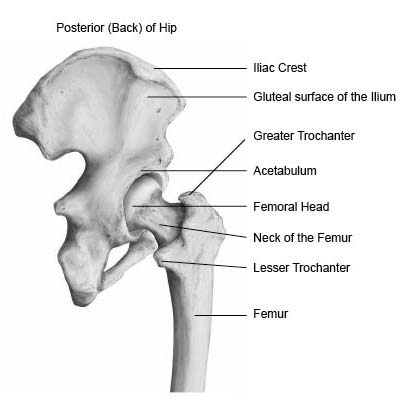Here is a discussion about the anatomy of your hip and the common ailments that we treat at River Ridge Chiropractic. You may have recently been diagnosed with one of these conditions, or are even wondering what is causing you hip pain. Most of these conditions can be treated naturally with effective results. Our office is familiar with all of them and can offer a variety of solutions, some that you can even do from home.
The hip joint is a ball-and-socket type joint and is formed where the thigh bone (femur) meets the three bones that make up the pelvis: the ilium at the rear, the ischium at the lower front, and the pubis above it. The thighbone has a ball-shaped knob on the end that fits into a socket formed in the hipbone. A smooth cushion of shiny white articular cartilage about 1/4 inch thick covers the femoral head and the acetabulum. The articular cartilage is kept slippery by fluid made in the synovial membrane (joint lining). Since the cartilage is smooth and slippery, the bones should move against each other easily and without pain. Large ligaments, tendons, and muscles around the hip joint (called the joint capsule) hold the bones (ball and socket) in place and keep it from dislocating. (http://healthpages.org/anatomy-function/hip-structure-function-common-problems/).
- Anterior — the abdominal side (front) of the hip
- Posterior — the back side of the hip
- Medial — the side of the hip closest to the spine
- Lateral — the side of the hip farthest from the spine
- Abduction — move away from the body (raising the leg)
- Adduction — move toward the body (lowering the leg)
- Proximal — located nearest to the point of attachment or reference, or center of the body
- Distal — located farthest from the point of attachment or reference, or center of the body
- Inferior — located beneath, under or below; under surface
The muscles of the thigh and lower back work together to keep the hip stable, aligned and moving. It is the muscles of the hip that allow the 4 basic movements of the hip:
- flexion – bend
- extension – straighten
- abduction – take the leg away from the body
- adduction – bring the leg back toward the body
The nerves in the hip supply the various muscles in the hip. These nerves include the femoral nerve, lateral femoral cutaneous nerve, and obturator nerve. The obturator nerve is also responsible for sensation over the thigh. The sciatic nerve is the most commonly recognized nerve in the hip and thigh. The sciatic nerve is large—as big around as your thumb—and travels beneath the gluteus maximus down the back of the leg and then branches on down to the foot.
Common Hip Issues Include:
- Aseptic or Avascular necrosis– a bone condition that results from poor blood supply to an area of bone, causing localized bone death.
- Congenital Dislocation– a complete or partial displacement of the femoral head out of the acetabulum.
- Perthes’ disease– blood supply to the femoral head is disrupted causing some of the bone to die. As part of the body’s normal healing process, the body breaks down this dead bone before new bone is made. But the resorption of this dead bone leads to structural weakness causing collapse and deformity.
- Aplasia of the acetabulum- defective development
- Coxa valga– deformity of the hip with increase in the angle of inclination between the neck and shaft of the femur.
- Coxa vara– deformity of the hip with decrease in the angle of inclination between the neck and shaft of the femur.
- Osteoarthritis- a joint disease caused by loss of cartilage.
- Dislocation– when the femur slips out of its socket in the hip bone.
- Bursitis- inflammation of sacs of synovial fluid.
- Bone tumor- neoplastic growth of tissue.
- Fracture- broken hips are serious, especially in older adults.
If you are experiencing hip pain or discomfort and are ready to book an appointment, I will be happy to work with you to figure out the best care pathway for your individual needs.
We also have more blog posts about hip pain for further reading.

